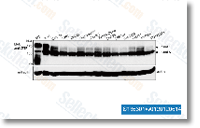Collectively, these information help the probability that crosstalk in between each the PI3K/Akt and MAPK pathways and nonge nomic ERa signaling can be enjoying a role in weight problems induced postmenopausal breast cancer progression, despite the fact that the PI3K/Akt pathway could be the much more critical mediator of those results. Added evidence to assistance this conclusion contains the observation that Tam alone is adequate to reduce obese patient sera induced Akt and ERK1/2 activation towards the levels observed in breast cancer cells grown in control patient serum. Also to demonstrating that obesity associated circulating aspects boost ERa mediated Akt and MAPK activation, we also identified that they selleck stimulated better Akt mediated phosphorylation of ERa at serine 167 in MCF 7 cells.
In contrast, publicity to obese patient sera didn’t upregulate ERa phosphoryla tion in the MAPK target website, but exploration ers have discovered that breast cancer cell MAPK action isn’t going to generally correlate with phosphorylation at this website. This ligand independent activation of ERa by way of its AF 1 NVPAUY922 domain is usually a purported mechanism by which endocrine resistance can create. Having said that, ligand independent ERa exercise is believed to be restricted to the nucleus, exactly where phosphorylated ERa acts like a transcription aspect or co element. As we did not detect a big difference in ERa genomic action, it is unclear regardless of whether the obese patient sera induced maximize in pERa has any biological significance. Provided the lack of any detectable result on genomic ERa exercise, it’s attainable the obese sera induced breast cancer cell viability and development may very well be indepen dent of circulating estrogen ranges.
If this hypothesis is confirmed, it might propose one particular mechanism by which weight problems may perhaps contribute to your development of resistance to aromatase inhibitor treatment, a obtaining with likely clinical implications. This conjecture, at the same time since the professional posed significance in the PI3K/Akt/mTOR pathway  in mediating the results of obesity related systemic fac tors, is supported from the literature on endocrine resis tance. By way of example, Miller et al. observed that induction of hormone independence by means of long lasting estrogen deprivation of ERa positive breast cancer cells was accompanied by an amplification of PI3K/Akt/mTor signaling linked to upstream IGF 1R/insulin receptor hyperactivation, much like the effects of obese patient sera publicity. PI3K signaling was essential to the induction of hormone independence, illustrating the key part this pathway plays from the growth of endocrine resistance. An earlier review by Beeram et al. demonstrated that MCF seven cells expressing a constitu tively lively Akt were refractory to therapy with letrozole, fulvestrant and tamoxifen, giving even further basis for our conclusions.
in mediating the results of obesity related systemic fac tors, is supported from the literature on endocrine resis tance. By way of example, Miller et al. observed that induction of hormone independence by means of long lasting estrogen deprivation of ERa positive breast cancer cells was accompanied by an amplification of PI3K/Akt/mTor signaling linked to upstream IGF 1R/insulin receptor hyperactivation, much like the effects of obese patient sera publicity. PI3K signaling was essential to the induction of hormone independence, illustrating the key part this pathway plays from the growth of endocrine resistance. An earlier review by Beeram et al. demonstrated that MCF seven cells expressing a constitu tively lively Akt were refractory to therapy with letrozole, fulvestrant and tamoxifen, giving even further basis for our conclusions.
Mirna Mimics
miRNA inhibitors for single or high throughput silencing
